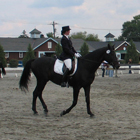
It may be a cliche, but dressage really is like peeling an onion. As you learn and grow as a rider and trainer, familiar concepts reveal themselves on new and deeper levels all the time. If I were to single out one thing that I wish I’d known early on in my career, it would be that horses need to be extremely sensitive to the leg and aids to become successful competitors at the Fed?eration Equestre Internationale (FEI) levels. I’m sure I thought I knew this and probably felt I had my horses “tuned up,” but it wasn’t until I experienced just how reactive my horse needed to be to do a line of straight, correct and expressive one-tempi changes that the concept really hit home.
For this level of work, the horse needs to show a definite response to the slightest whisper from your calf. Some horses are naturally more sensitive than others, of course, but diligence on the part of the rider pays off with a horse that is engaged and a joy to ride, no matter what level you are schooling. If your horse doesn’t respond to a light aid, you must ask again with a stronger aid until you achieve the desired response. This needs to be repeated every time, every ride. Don’t worry if he overreacts at first, because you’re just looking for a forward response. Reward him for this and know you can refine it later. Consistency is the key. So always give the horse the opportunity to respond to the lightest of aids.
I can’t emphasize enough the importance of consistency. If you only demand a certain level of sensitivity when you’re riding in the dressage arena but let it go when you’re out on the trail, for instance, you’ll not only confuse your horse, you’ll suggest to him that he just doesn’t have to hustle every single time you ask.
This doesn’t mean that you allow your horse to lose his rhythm or balance or run through the bridle. Reaction to the leg is only one part of the equation. The half halt is another key part. As the horse’s level of training increases, he learns to listen to your seat and hands and channels the forward, running energy into more engagement and brilliance. When I’m teaching my students, I often refer to the different “gears” you need to be able to access when you’re riding. But without a gas pedal, all the gears in the world are useless.
Every horse has a different job description, and the level of sensitivity desirable in a competitive Grand Prix horse would be unsuitable for a lower-level amateur’s horse. Riders need to feel safe and comfortable and not be over mounted. The concept remains the same, though: a horse that is responsive to a light leg aid, no matter what the level, is one step further toward being truly on the aids. And isn’t that what we are all seeking?
Kristina Harrison-Naness is a U.S. Dressage Federation (USDF) gold medalist. In 2003, she won a Pan American Games team gold medal and was U.S. Equestrian Team Intermediaire I Champion. On Rociero XV she has won the USDF All-Breeds award from Prix St. Georges to Intermediaire II. Kristina is based in Los Angeles, Calif., at Angele Farms.











